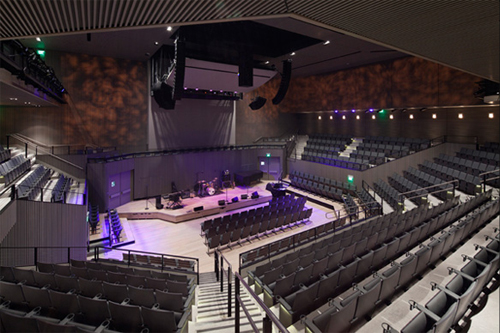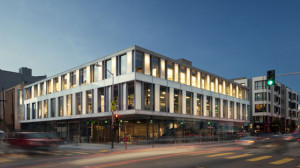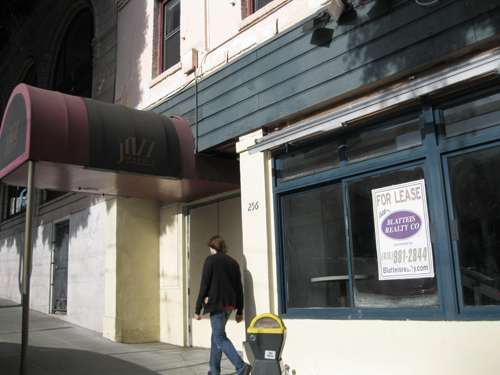“Small jazz clubs cannot survive in this day and age,” says Pascal Bokar Thiam, a prominent jazz guitarist and academic who co-owns Savanna Jazz, a Mission District jazz club that opened in 2003. “San Francisco used to be a Mecca for jazz. But the art form doesn’t necessarily die because small jazz clubs cannot survive. In the context of San Francisco, what SFJAZZ is doing is important because it puts front and center the reality that America has an art form of its own. And that art form expresses the highest standards of aesthetics that humanity has been able to make. By cultivating this, SFJAZZ is doing something extremely important to the general health of jazz.”
But jazz elders are now debating whether there’s a substantial audience for jazz in San Francisco beyond the confines of SFJAZZ’s programming. Sonny Buxton, a deejay at Bay Area radio jazz station KCSM who was the musical director of Jazz at Pearl’s before its 2003 closing, says an increase in college jazz programs around the country has helped produce a new generation of jazz-goers steeped in the music’s history.
“There’s a new, upcoming jazz audience that’s young and vibrant,” Buxton says. “They’re into jazz and world music and a lot of different things. One thing today that wasn’t in existence when I was coming up is that virtually every college and university in the country today has a jazz program. That means a lot of young people are being exposed to it.”

The decrease of San Francisco jazz clubs in the past 20 years may be due more to real-estate economics than a leveling-off of jazz audiences. Jazz at Pearl’s shut down in 2003 when the building’s owner declined to give the club more than a five-year lease. (A new Jazz at Pearl’s opened in the same location but closed its doors in 2008 over similar lease issues.) Savanna Jazz faced foreclosure when a bank refused to negotiate new terms. Facing a possible bankruptcy, Yoshi’s San Francisco is trying to redo the terms of loans it received from the now-defunct San Francisco Redevelopment Agency.
Will audiences support these venues at their most vulnerable economic times? Thiam says the audience for jazz is limited because jazz and music education have disappeared at the grade school, middle school, and high school levels. San Francisco’s jazz scene, he says, reflects a nationwide trend: among younger audiences, jazz is losing out to hip-hop, rap, pop, and other music. Young black students have even told Thiam that they consider jazz a “white music” that has little relevance to their lives.
“Jazz is not profitable, primarily because there is no audience for it — it’s an art form that isn’t taught in schools,” says Thiam, whose club is located on Mission Street between 25th and 26th Streets. “Schools teach Mozart and Beethoven, but Mozart and Beethoven are the products and the geniuses of Europe. In America, we have our geniuses that created an art form that’s performed all over the planet. Singapore has a jazz festival. Turkey has a jazz festival. Denmark has a jazz festival. And these geniuses are called King Oliver, Louis Armstrong, Duke Ellington, and so forth. Because our student population as early as elementary school is not knowledgeable about people who created an art form that lifted this nation to the status of a cultural superpower, we have this vacuum. There is no energy for young people to go to jazz clubs — not because they don’t like jazz; it’s simply because they don’t know anything about jazz. This is an area where culture has impacted business. And as a result, business by dwindling impacts the culture.”
The Danish government, Thiam says, gives financial support to the country’s jazz clubs — upwards of $125,000 a year to each club, “so they can operate a higher-standard learning environment.” While the U.S. government may not have a similar approach, moneyed institutions like SFJAZZ should consider supporting small jazz clubs, which are incubators of upcoming jazz musicians and singers, says Thiam and Franzo King, the saxophone-playing Archbishop at Saint John Coltrane African Orthodox Church on Fillmore Street. The San Francisco church, which some jazz fans consider a de facto jazz club, was evicted from its longtime home on Divisadero Street in 2000 because of a massive rent increase.
King views the opening of SFJAZZ’s new center with decidedly mixed feelings, saying its new location in a gentrified neighborhood anchors San Francisco’s jazz scene away from the African-American community that historically supported jazz in the city. Popular jazz in San Francisco, King worries, may become an art form performed in a symphony-like environment where audiences are snazzily dressed and discouraged from being vocal during performances. “SFJAZZ moved out of the community where it was born,” King says.
After opening its doors last month, SFJAZZ has had a series of sold-out performances, and is well on its way to raising all necessary funding. So far, donors have contributed $54.9 million, with nine donors giving $1 million or more. One anonymous contribution totaled $25 million. “The SFJAZZ Center believes that rising water raises all ships,” says SFJAZZ spokesperson Marshall Lamm. “We hope the Center can generate more exposure for the genre that will then increase the interest in jazz so more people go out to experience live music in every venue.”
Thiam is taking a wait-and-see approach. In the meantime, Savanna Jazz is negotiating new loan terms with its bank, says Thiam, who is hopeful the jazz club, with its nightly jazz and its prominent display of jazz memorabilia, will be around for the foreseeable future. “We’ll be here,” Thiam says in his office on a recent Saturday night, “as long as the spirit of Louis Armstrong says we’re going to be here.”
As Thiam spoke, the Montreal-based jazz singer Jeri Brown and her trio of top-flight musicians performed another song for an enthusiastic audience of 30. That number may seem small, but even famous jazz clubs like the Village Vanguard in New York get crowds that are similar in number. The night I visited Savanna Jazz, one audience member moved her hands to the rhythm of Brown’s beats, as if the woman were on stage with Brown and her trio. The woman seemed to be in a trance, and her seat was practically shaking with feeling. Nearby, other audience members were also riveted, even if they were less demonstrative.
On that night, jazz was alive and well at a small club in San Francisco — just like it was in the old days when John Coltrane, Miles Davis, and other big names would visit San Francisco and perform in venues that were not much bigger than a studio apartment. Jazz spots like Savanna Jazz helped forge the cultural environment that led to SFJAZZ in the first place. A venue like Savanna Jazz is the only place to see an artist like Jeri Brown, who’s highly considered in jazz circles (and a new favorite of mine) but not yet so popular she could sell out SFJAZZ’s concert hall.
“Small jazz venues are the incubators of local talent,” says Thiam. “In order for this art form to survive, small jazz clubs have to be able to survive. It’s very important for big entities like SFJAZZ and Lincoln Center in New York to realize that there has to be a partnership with small jazz venues. If that becomes a commitment — if the big outfits that have the financial endowment hold hands with small jazz venues — then only then will the tide lift all boats.”




